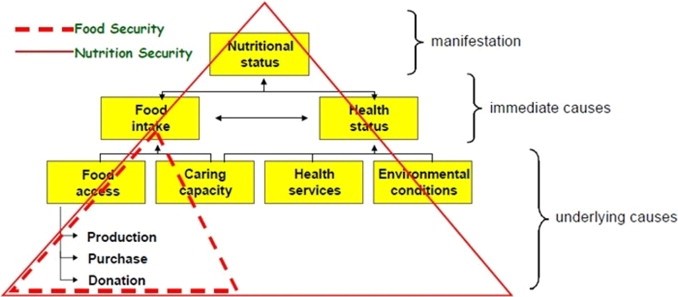[ad_1]
Introduction:
The health of a country’s agri-food systems determines the health of its people.
The findings from the first round of the Fifth National Family Health Survey suggest that nutrition-related indicators have worsened in most States.
The survey covers 17 States and five Union Territories, which comprise 54% of India’s population.
In addition, findings from the Comprehensive National Nutrition Survey (2016-18) have highlighted the role of micro-nutrient malnutrition.
Context:
World Food Day is celebrated every year on October 16 to commemorate the date of the founding of the United Nations Food and Agriculture Organisation in 1945.
The day is also observed by organisations like World Food Programme and International Fund for Agricultural Development.
Since 1981, World Food Day has celebrated various themes to highlight the importance of food security, with most of them revolving around agriculture.
The theme for World Food Day this year is “Our actions are our future- Better production, better nutrition, a better environment and a better life”.
Challenges for Nutritional Security:
- The biggest impact of Covid-19 on food security has been on almost all low-and middle-income countries.
- The Global Food Policy Report 2021 (by the International Food Policy Research Institute (IFPRI)) stated that the impacts of rising poverty and reduced livelihoods are reflected clearly in rising levels of food insecurity and decreasing diet quality.
- According to UNICEF, 38% of children younger than five years of age in India are stunted, a manifestation of chronic undernutrition.
- Stunting and other forms of under-nutrition are thought to be responsible for nearly half of all child deaths globally.
- In Bihar and Uttar Pradesh, the stunting rate is around 48% and 46% respectively. It shows that in these states almost every 2nd child is stunted.
- There are high rates of stunting among children in the poorest wealth quintile is (51.4%), Scheduled Tribes (43.6%) and Scheduled Castes (42.5%), and children born to mothers with no education (51%).
- The country has observed an increase in the prevalence of obesity among the adult population from 3.1% in 2012 to 3.9% in 2016.
- The prevalence of anaemia among women of reproductive age has only marginally improved from 53.2%in 2012 to 53% in 2019.
A multi-pronged approach for Nutritional Security:
- Addressing the complex problem of malnutrition is a colossal task for which we need to look at agri-food systems as a whole and adopt a multi-pronged approach.
- While COVID-19 has exacerbated the nutrition issue, climate change has challenged agricultural production itself.
- However, the country’s agri-food systems are facing new and unprecedented challenges, especially related to economic and ecological sustainability, nutrition and the adoption of new agricultural technologies.
- The edifice of India’s biosecurity remains vulnerable to disasters and extreme events.
- The agri-food systems are the most important part of the Indian economy.
- India produces sufficient food, feed and fibre to sustain about 18% of the world’s population (as of 2020).
- Agriculture contributes about 16.5% to India’s GDP and employs 42.3% of the workforce (2019-20). For Indians to eat better, India must sow better.
- A structural shift in dietary pattern and nutrition requires a shift in production.
- Pathways for nutritional security consist of improving dietary diversity, kitchen gardens, reducing post-harvest losses, making safety net programmes more nutrition-sensitive, women’s empowerment, enforcement of standards and regulations, improving Water, Sanitation and Hygiene, nutrition education, and effective use of digital technology.
Way Forward:
- There is an urgent need for reorientation of the long-term direction of agri-food systems to not only enhance farm incomes but also ensure better access to safe and nutritious foods.
- Additionally, the agri-food systems need to be reoriented to minimise cost on the environment and the climate.
- This need is recognised by the theme of World Food Day 2021: ‘Our actions are our future.
- Better production, better nutrition, a better environment and a better life’. The four betters represent the Food and Agriculture Organization (FAO)’s contribution to the Sustainable Development Goals and other high-level aspirational goals.
- World Food Day marks the foundation day of the FAO. FAO has enjoyed valuable partnership with India since it began operations in 1948.
- More recently, FAO has been engaged with the Indian government for mainstreaming agrobiodiversity, greening agriculture, promoting nutrition-sensitive agriculture and strengthening national food security.
- FAO’s support for the transformation of agri-food systems is rooted in agro-ecology. The more diverse an agricultural system, the greater its ability to adapt to shocks.
- Different combinations of integrated crop-livestock-forestry-fishery systems can help farmers produce a variety of products in the same area, at the same time or in rotation.
Conclusion:
India also has to transform its food systems, which have to be inclusive and sustainable for higher farm incomes and nutrition security. In this context, it would be useful to look at India’s policies across food systems.
In January 2021, FAO in collaboration with NITI Aayog and the Ministry of Agriculture convened a National Dialogue to evolve a framework for the transition to a more sustainable agri-food systems by 2030 and identify pathways for enhancing farmers’ income and achieving nutritional security.
A sustainable agri-food system is one in which a variety of sufficient, nutritious and safe foods are made available at an affordable price to everyone, and nobody goes hungry or suffers from any form of malnutrition.
Less food is wasted, and the food supply chain is more resilient to shocks.
Food systems can help combat environmental degradation or climate change. Sustainable agri-food systems can deliver food security and nutrition for all, without compromising the economic, social and environmental bases.
[ad_2]


